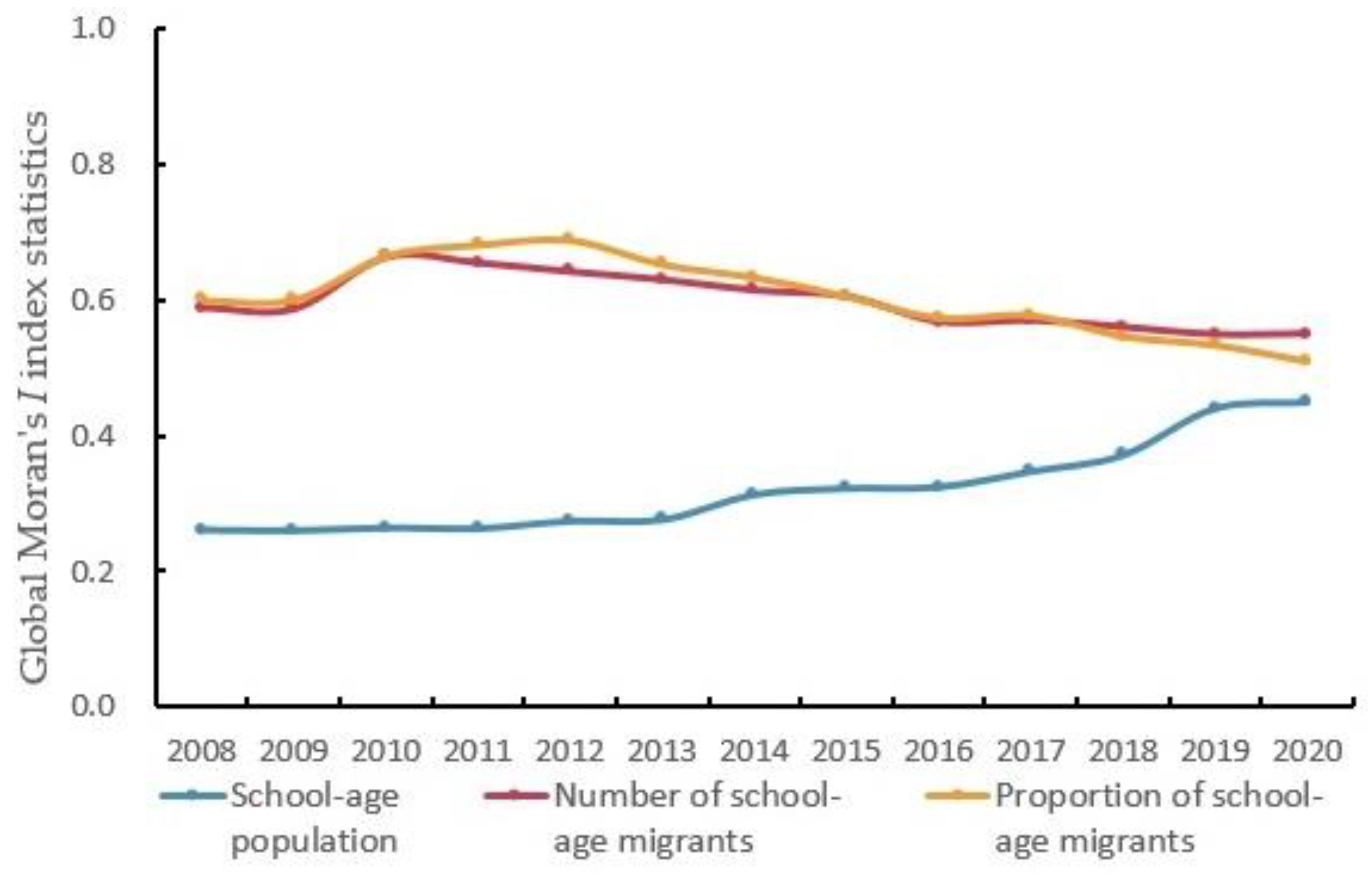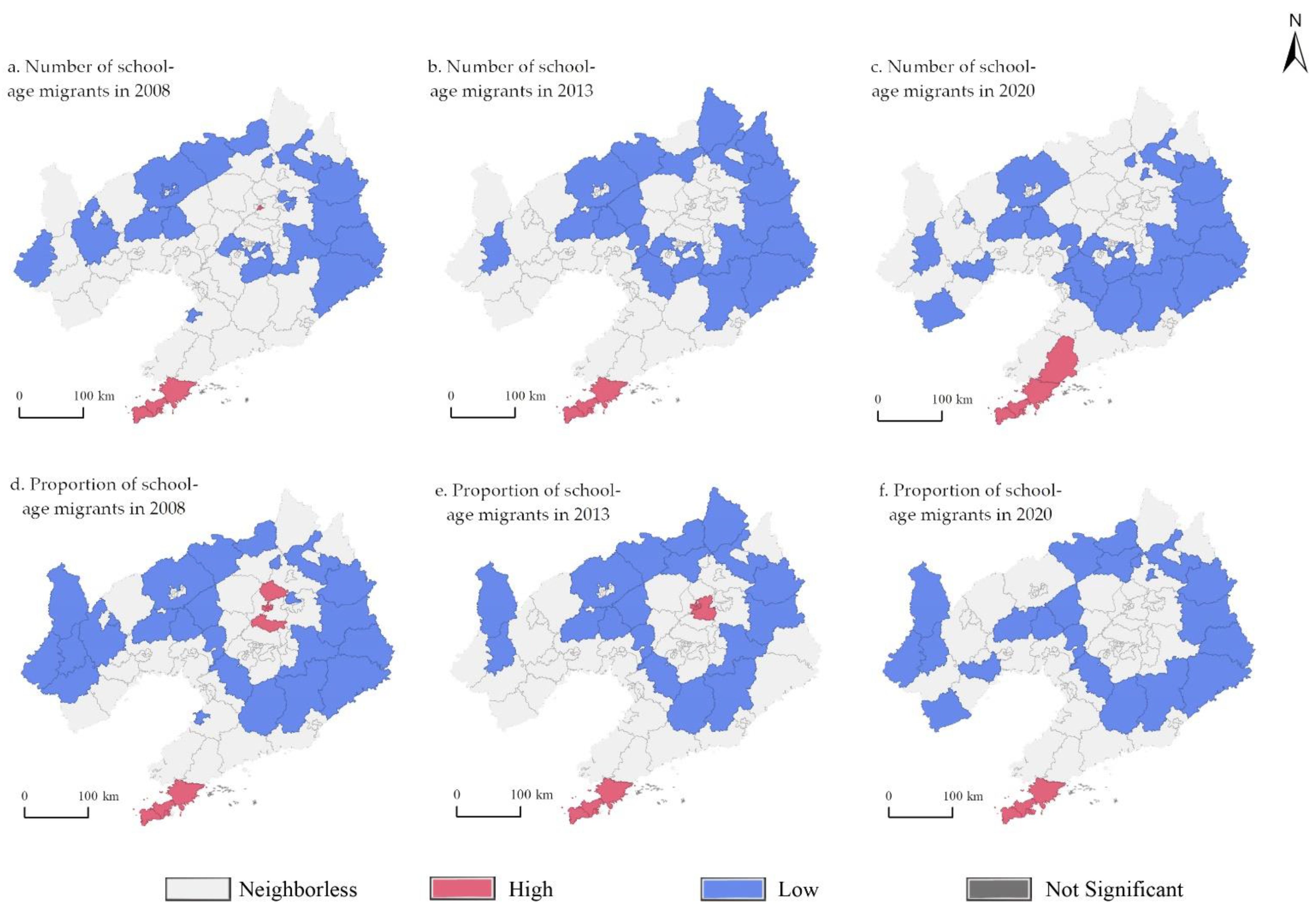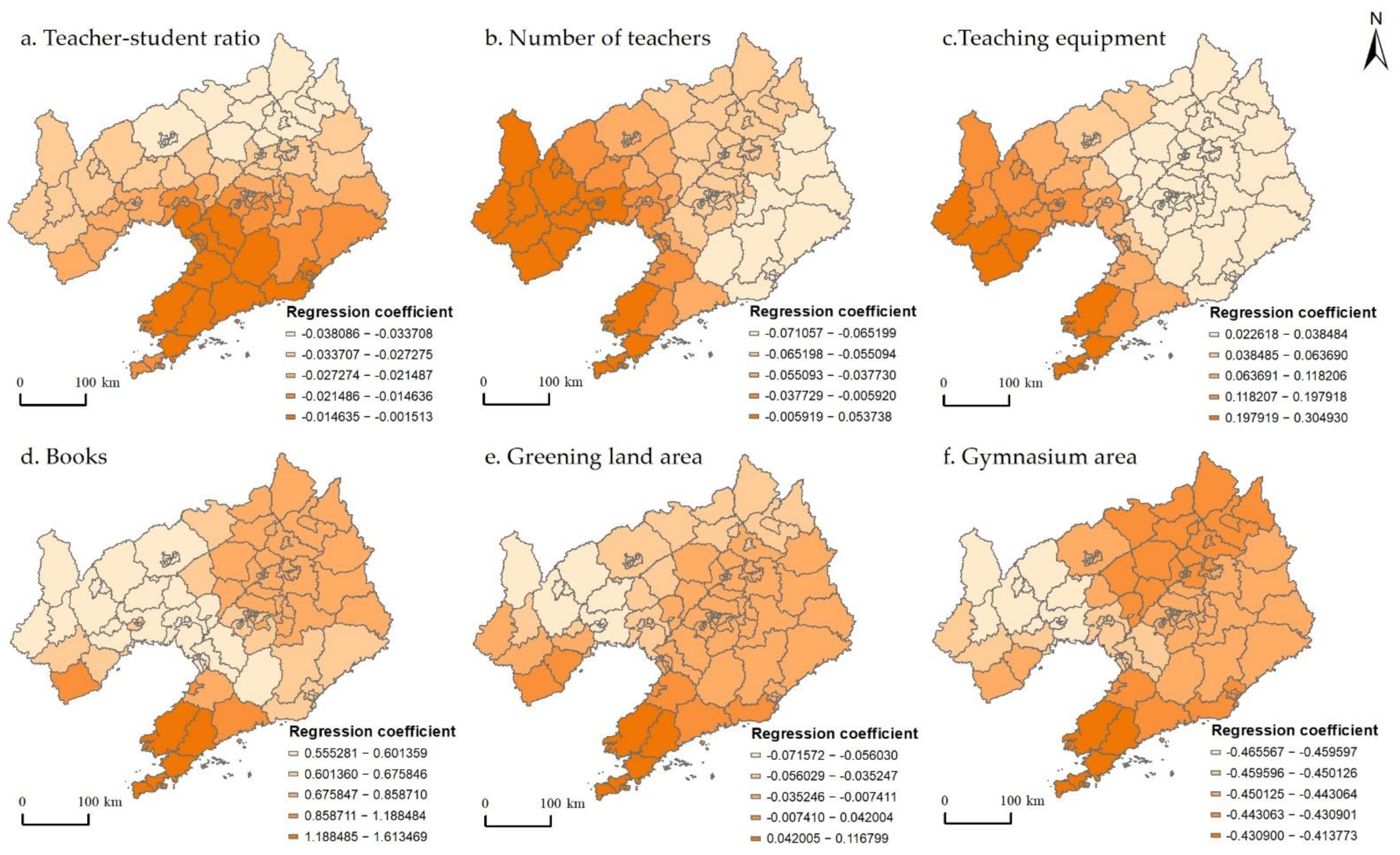Spatiotemporal Differentiation of the School-Age Migrant Population in Liaoning Province, China, and Its Driving Factors
Abstract
:1. Introduction
2. Materials and Methods
2.1. Research Area
2.2. Data and Processing
2.3. Research Methods
2.3.1. Spatial Autocorrelation
2.3.2. Local G Coefficient
2.3.3. MGWR Model
3. Results
3.1. Overall Distribution of the School-Age Migrant Population
3.1.1. Number of School-Age Migrants
3.1.2. Proportion of School-Age Migrants
3.2. Spatial Autocorrelation Characteristics of the School-Age Migrant Population
3.3. Factors Driving the Spatial Differentiation of the School-Age Migrant Population
3.3.1. Variable Selection and Preprocessing
3.3.2. Model Estimation Result
3.3.3. Analysis of Model Estimation Results
4. Discussion
4.1. Overall Distribution of the School-Age Migrant Population
4.2. Factors Driving the Spatiotemporal Differentiation of the School-Age Migrant Population
4.3. Study Limitations
5. Conclusions
Author Contributions
Funding
Institutional Review Board Statement
Informed Consent Statement
Data Availability Statement
Acknowledgments
Conflicts of Interest
References
- You, H.; Yang, J.; Xue, B.; Xiao, X.; Xia, J.; Jin, C.; Li, X. Spatial evolution of population change in northeast China during 1992–2018. Sci. Total Environ. 2021, 776, 146023. [Google Scholar] [CrossRef]
- Jina, S.; Yangab, J.; Wangb, E.; Liuc, J. The influence of high-speed rail on ice–snow tourism in northeastern China. Tour. Manag. 2020, 78, 104070. [Google Scholar] [CrossRef]
- Yu, S.; Chen, B.; Levesque-Bristol, C.; Vansteenkiste, M. Chinese education examined via the lens of self-determination. Educ. Psychol. Rev. 2018, 30, 177–214. [Google Scholar] [CrossRef]
- Ministry of Education of the People’s Republic of China. National Statistical Bulletin on Educational Development [EB/OL]; Ministry of Education of the People’s Republic of China: Beijing, China. Available online: http://www.moe.gov.cn/jyb_sjzl/sjzl_fztjgb/ (accessed on 10 September 2021).
- Yu, M.; Crowley, C.B. The discursive politics of education policy in China: Educating migrant children. China Q. 2020, 241, 87–111. [Google Scholar] [CrossRef]
- Bosker, M.; Brakman, S.; Garretsen, H.; Schramm, M. Relaxing hukou: Increased labor mobility and China’s economic geography. J. Urban Econ. 2012, 72, 252–266. [Google Scholar] [CrossRef] [Green Version]
- Fu, Y.; Gabriel, S.A. Labor migration, human capital agglomeration and regional development in China. Reg. Sci. Urban Econ. 2012, 42, 473–484. [Google Scholar] [CrossRef]
- Chen, L.; Xi, M.; Jin, W.; Hu, Y. Spatial pattern of long-term residence in the urban floating population of China and its influencing factors. Chin. Geogr. Sci. 2021, 31, 342–358. [Google Scholar] [CrossRef]
- Wang, Y.; Wang, Z.; Zhou, C.; Liu, Y.; Liu, S. On the settlement of the floating population in the pearl river delta: Understanding the factors of permanent settlement intention versus housing purchase actions. Sustainability 2020, 12, 9771. [Google Scholar] [CrossRef]
- Zhao, M.; Liu, S.; Qi, W. Exploring the differential impacts of urban transit system on the spatial distribution of local and floating population in Beijing. J. Geogr. Sci. 2017, 27, 731–751. [Google Scholar] [CrossRef]
- Dong, X.; Jiang, X. Population mobility model & floating growth spatial types and their influencing factors in southwest China. In 2019 International Conference on Management, Finance and Social Sciences Research (MFSSR 2019); Francis Academic Press: London, UK, 2019. [Google Scholar]
- Xu, J.; Takahashi, M. Progressing vulnerability of the immigrants in an urbanizing village in coastal China. Environ. Dev. Sustain. 2021, 23, 8012–8026. [Google Scholar] [CrossRef]
- Karachurina, L.B.; Mkrtchyan, N.V. Intraregional population migration in Russia: Suburbs outperform capitals. Reg. Res. Russ. 2021, 11, 48–60. [Google Scholar] [CrossRef]
- Ma, W.; Jiang, G.; Wang, D.; Li, W.; Guo, H.; Zheng, Q. Rural settlements transition (RST) in a suburban area of metropolis: Internal structure perspectives. Sci. Total Environ. 2018, 615, 672–680. [Google Scholar] [CrossRef]
- O’Brien, R.J. Model for planning the location and size of urban schools. Socio-Econ. Plan. Sci. 1969, 2, 141–153. [Google Scholar] [CrossRef]
- Morrill, R.L. Efficiency and equity of optimum location models. Antipode 1974, 6, 41–46. [Google Scholar] [CrossRef]
- Butler, T.; Hamnett, C. Praying for success? Faith schools and school choice in east London. Geoforum 2012, 43, 1242–1253. [Google Scholar] [CrossRef]
- Mustapha, O.-O.; Akintunde, O.; Alaga, A.; Badru, R.; Ogbole, J.; Samuel, P.; Samuel, S. Spatial distribution of primary schools in Ilorin West local government area, Kwara State, Nigeria. J. Sci. Res. Rep. 2016, 9, 1–10. [Google Scholar] [CrossRef]
- Andersson, E.; Malmberg, B.; Östh, J. Travel-to-school distances in Sweden 2000–2006: Changing school geography with equality implications. J. Transp. Geogr. 2012, 23, 35–43. [Google Scholar] [CrossRef] [Green Version]
- Chi, G.Q.; Ho, H.C. Population stress: A spatiotemporal analysis of population change and land development at the county level in the contiguous United States, 2001–2011. Land Use Policy 2018, 70, 128–137. [Google Scholar] [CrossRef] [PubMed]
- Gao, Y.; He, Q.; Liu, Y.; Zhang, L.; Wang, H.; Cai, E. Imbalance in spatial accessibility to primary and secondary schools in China: Guidance for education sustainability. Sustainability 2016, 8, 1236. [Google Scholar] [CrossRef] [Green Version]
- Lu, S.; Rios, J.A.; Huang, C.-C. Mindfulness, emotion and behaviour: An intervention study with Chinese migrant children. Child. Soc. 2018, 32, 290–300. [Google Scholar] [CrossRef]
- Zhang, W.; Chong, Z.; Li, X.; Nie, G. Spatial patterns and determinant factors of population flow networks in China: Analysis on Tencent location big data. Cities 2020, 99, 102640. [Google Scholar] [CrossRef]
- Zhang, D.; Zhou, C.; Xu, W. Spatial-temporal characteristics of primary and secondary educational resources for relocated children of migrant workers: The case of Liaoning province. Complexity 2020, 2020, 1–13. [Google Scholar] [CrossRef]
- Li, C.; Wu, Z.; Zhu, L.; Liu, L.; Zhang, C. Changes of spatiotemporal pattern and network characteristic in population flow under COVID-19 epidemic. ISPRS Int. J. Geo-Inf. 2021, 10, 145. [Google Scholar] [CrossRef]
- Chan, K.W.; Ren, Y. Children of migrants in China in the twenty-first century: Trends, living arrangements, age-gender structure, and geography. Eurasian Geogr. Econ. 2018, 59, 133–163. [Google Scholar] [CrossRef]
- Ye, B. Reform of compulsory education system and urban integration of floating population. World Sci. Res. J. 2021, 7, 184–197. [Google Scholar]
- Zhao, M.; Hannum, E. Stark choices: Work-family tradeoffs among migrant women and men in urban China. Chin. Sociol. Rev. 2019, 51, 365–396. [Google Scholar] [CrossRef] [PubMed]
- Huijsmans, R. Child migration and questions of agency. Dev. Chang. 2011, 42, 1307–1321. [Google Scholar] [CrossRef]
- Tan, S.; Li, Y.; Song, Y.; Luo, X.; Zhou, M.; Zhang, L.; Kuang, B. Influence factors on settlement intention for floating population in urban area: A China study. Qual. Quant. 2017, 51, 147–176. [Google Scholar] [CrossRef]
- Luo, J.; Zhang, X.; Wu, Y.; Shen, J.; Shen, L.; Xing, X. Urban land expansion and the floating population in China: For production or for living? Cities 2018, 74, 219–228. [Google Scholar] [CrossRef]
- Liu, Z.; Wang, Y.; Chen, S. Does formal housing encourage settlement intention of rural migrants in Chinese cities? A structural equation model analysis. Urban Stud. 2016, 54, 1834–1850. [Google Scholar] [CrossRef]
- Yu, D.; Zhang, Y.; Wu, X. Correction to: How socioeconomic and environmental factors impact the migration destination choices of different population groups in China: An eigenfunction-based spatial filtering analysis. Popul. Environ. 2020, 41, 396. [Google Scholar] [CrossRef] [Green Version]
- Liu, S.; Zhao, X. How far is educational equality for China? Analysing the policy implementation of education for migrant children. Educ. Res. Policy Pract. 2018, 18, 59–74. [Google Scholar] [CrossRef]
- Stiefel, L.; Elbel, B.; Prescott, M.P.; Aneja, S.; Schwartz, A.E. School wellness programs: Magnitude and distribution in New York city public schools. J. Sch. Health 2017, 87, 3–11. [Google Scholar] [CrossRef] [PubMed] [Green Version]
- Fan, C.C.; Li, T. Split households, family migration and urban settlement: Findings from China’s 2015 national floating population survey. Soc. Incl. 2020, 8, 252–263. [Google Scholar] [CrossRef]
- Goodchild, M.F. What problem? Spatial autocorrelation and geographic information science. Geogr. Anal. 2009, 41, 411–417. [Google Scholar] [CrossRef] [Green Version]
- Getis, A.; Ord, J.K. The analysis of spatial association by use of distance statistics. In Advances in Spatial Science; Springer: Berlin/Heidelberg, Germany, 2010; pp. 127–145. [Google Scholar]
- Wulder, M.; Boots, B. Local spatial autocorrelation characteristics of remotely sensed imagery assessed with the Getis statistic. Int. J. Remote Sens. 1998, 19, 2223–2231. [Google Scholar] [CrossRef]
- Fotheringham, A.S.; Yang, W.; Kang, W. Multiscale geographically weighted regression (MGWR). Ann. Am. Assoc. Geogr. 2017, 107, 1247–1265. [Google Scholar] [CrossRef]
- Hastie, T.; Tibshirani, R. Generalized additive models: Some applications. J. Am. Stat. Assoc. 1987, 82, 371–386. [Google Scholar] [CrossRef]
- Reis, J.; Ballinger, R.C. Creating a climate for learning-experiences of educating existing and future decision-makers about climate change. Mar. Policy 2020, 111. [Google Scholar] [CrossRef]
- Li, J.; Shi, Z.; Xue, E. The problems, needs and strategies of rural teacher development at deep poverty areas in China: Rural schooling stakeholder perspectives. Int. J. Educ. Res. 2020, 99, 101496. [Google Scholar] [CrossRef]
- Boldermo, S.; Ødegaard, E.E. What about the migrant children? The state-of-the-art in research claiming social sustainability. Sustainability 2019, 11, 459. [Google Scholar] [CrossRef] [Green Version]
- Kumar, S.; Lal, R.; Liu, D. A geographically weighted regression kriging approach for mapping soil organic carbon stock. Geoderma 2012, 189–190, 627–634. [Google Scholar] [CrossRef]
- Yang, J.; Bao, Y.; Zhang, Y.; Li, X.; Ge, Q. Impact of accessibility on housing prices in Dalian city of China based on a geographically weighted regression model. Chin. Geogr. Sci. 2018, 28, 505–515. [Google Scholar] [CrossRef] [Green Version]
- Fotheringham, A.S.; Yue, H.; Li, Z. Examining the influences of air quality in China’s cities using multi-scale geographically weighted regression. Trans. GIS 2019, 23, 1444–1464. [Google Scholar] [CrossRef]
- Li, Z.; Fotheringham, A.S. Computational improvements to multi-scale geographically weighted regression. Int. J. Geogr. Inf. Sci. 2020, 34, 1378–1397. [Google Scholar] [CrossRef]





| Variable | Bandwidth | Mean | STD | Min | Median | Max |
|---|---|---|---|---|---|---|
| Teacher-student ratio | 99.000 | −0.024 | 0.009 | −0.038 | −0.025 | −0.002 |
| Number of teachers | 86.000 | −0.036 | 0.037 | −0.071 | −0.058 | 0.054 |
| Books | 43.000 | 0.752 | 0.276 | 0.555 | 0.685 | 1.613 |
| Teaching equipment | 68.000 | 0.081 | 0.079 | 0.023 | 0.034 | 0.305 |
| Greening land area | 79.000 | −0.019 | 0.044 | −0.072 | −0.029 | 0.117 |
| Gymnasium area | 93.000 | −0.445 | 0.011 | −0.466 | −0.445 | −0.414 |
| Intercept | 47.000 | −0.112 | 0.057 | −0.255 | −0.113 | 0.009 |
Publisher’s Note: MDPI stays neutral with regard to jurisdictional claims in published maps and institutional affiliations. |
© 2021 by the authors. Licensee MDPI, Basel, Switzerland. This article is an open access article distributed under the terms and conditions of the Creative Commons Attribution (CC BY) license (https://creativecommons.org/licenses/by/4.0/).
Share and Cite
Xu, W.; Song, C.; Sun, D.; Yu, B. Spatiotemporal Differentiation of the School-Age Migrant Population in Liaoning Province, China, and Its Driving Factors. Land 2021, 10, 1036. https://doi.org/10.3390/land10101036
Xu W, Song C, Sun D, Yu B. Spatiotemporal Differentiation of the School-Age Migrant Population in Liaoning Province, China, and Its Driving Factors. Land. 2021; 10(10):1036. https://doi.org/10.3390/land10101036
Chicago/Turabian StyleXu, Wenwen, Chunrui Song, Dongqi Sun, and Baochu Yu. 2021. "Spatiotemporal Differentiation of the School-Age Migrant Population in Liaoning Province, China, and Its Driving Factors" Land 10, no. 10: 1036. https://doi.org/10.3390/land10101036
APA StyleXu, W., Song, C., Sun, D., & Yu, B. (2021). Spatiotemporal Differentiation of the School-Age Migrant Population in Liaoning Province, China, and Its Driving Factors. Land, 10(10), 1036. https://doi.org/10.3390/land10101036






